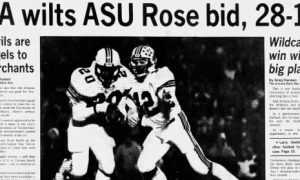
EDITOR’S NOTE: Due to the controversy surrounding Sean Miller’s technical foul in last year’s Pac-12 Tournament, an event in which former Pac-12 director of officiating Ed Rush reportedly placed a bounty on Miller to be thrown out or given a technical, this site will monitor the league’s officials during the course of the season through the conference tournament in March. The integrity of the game and its officiating was called into question by Rush’s actions, which ultimately led to his resignation.

Tommy Nunez, pictured here, referees games in the West coast, where his father Tommy Nunez Sr. is a regional advisor for NCAA director of officiating John Adams
Former NBA ref Tommy Nunez, incorporated into Pac-12 officiating last year by Rush after Nunez was fired by the NBA, worked his first conference game last night in Stanford’s 80-48 win over visiting Washington State.
Rush was also Nunez’s boss when Rush was the NBA’s director of officiating. Nunez, who also officiates West Coast Conference games, has worked 21 games overall this season.
His father Tommy Nunez Sr., another longtime NBA official, is a West regional advisor for NCAA national coordinator of men’s basketball officiating John Adams. Nunez Sr. is based out of Phoenix. He is one of four regional advisors who reports to Adams.
That means Nunez Sr. can grade his son’s performance.
According to CBSSports.com, the regional advisors will see 400-450 officials and almost 500 games collectively, in person, this year and evaluate them for tourney consideration. Each have responsibility for overseeing eight leagues and will contribute to an “exhaustive file” that will be presented to Adams by Feb. 1. Adams himself travels to games. He attended Kentucky’s overtime loss at Arkansas on Tuesday.
CBSSports.com also reported today that Adams sent a memo to officials stating that he is not pleased with the lack of hand-checking fouls. Hand-checking fouls and charging/blocking fouls are major points of emphasis with refs this year. How they are called will affect a referee’s ability to officiate in the NCAA tournament. Here is the memo published by CBSSports.com (the “10-1-4” rule is the new protocol for whistles against hand-checking):
1. Very inconsistent enforcement of 10-1-4, especially in the back court.
2. We are letting defenders “show their hands” but foul with the lower body.
3. In games where 10-1-4 is enforced fairly well, that enforcement tends to fade late in close games.
4. Post Play is as rough as I have ever seen it. Not calling the 1st or second foul in these scrums, invariably leads to a “retaliation foul” later in the sequence.
5. There is still way too much illegal contact committed against players without the ball. That was a 2013-14 point of emphasis.
I listened to an announcer last night on ESPN say: “what they (officials) work on and talk about in November and December eventually goes away in January and February and we get back to playing college basketball”. Our challenge is to prove him wrong.
The following three charts involved a few hours of my time putting together data of league referees. I will update the data through the season. Here is a brief description of each:
Chart 1 and 2: Chart 1 indicates the referees who have officiated at least three Pac-12 games in the first three weeks of the season. Chart 2 lists all officials.
Within the graphic, it first lists the years the referees have worked college basketball games per statsheet.com.
The conference record shown indicates the cumulative combined conference records of the teams at the time they played in the game called by the ref. For example, Nixon, who officiated the Pac-12 tournament title game last March between UCLA and Oregon, has worked in games this year that featured teams that were a combined 10-4 at tip off: (Arizona, 1-0, vs. Washington, 1-0; Oregon, 1-0, vs. Colorado, 1-0; Cal, 2-0, vs. Oregon State, 1-2; and Arizona, 3-0, vs. USC, 0-2).
The “Rank” column is the number of games called that involve AP Top 25 teams. Also listed are stats related to games called by a referee’s crew: Personal fouls, average of personal fouls, disqualifications, technical fouls, free-throw attempts and free-throw attempt average a game.
Chart 3 and 4: Chart 3 indicates the number of overall games called by a ref of a particular conference team. Chart 4 has the same principle but indicates only certain locations where the referee called a game.
CHART ONE: MOST-USED OFFICIALS
[csv src=http://wildaboutazcats.net/wp-content/uploads/2014/01/Pac12RefsMostGames3.csv]
CHART TWO: ALL OFFICIALS
[csv src=http://wildaboutazcats.net/wp-content/uploads/2014/01/Pac12RefsOverall3.csv]
CHART THREE: REFS BY TEAMS CALLED
[csv src=http://wildaboutazcats.net/wp-content/uploads/2014/01/Pac12RefsAllGames3.csv]
CHART FOUR: REFS BY LOCATIONS CALLED
[csv src=http://wildaboutazcats.net/wp-content/uploads/2014/01/Pac12RefsRoadGames31.csv]
WILDABOUTAZCATS.net publisher, writer and editor Javier Morales is a former Arizona Press Club award winner. He also writes articles for Bleacher Report, Lindy’s College Sports and TucsonCitizen.com.
[rps-paypal]
|
|






















